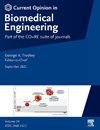Spatiotemporally-patterned biomaterials for organoid culture
IF 4.2
3区 工程技术
Q2 ENGINEERING, BIOMEDICAL
引用次数: 0
Abstract
Spatiotemporally-patterned biomaterials have emerged as powerful tools for enhancing organoid development and functionality by recreating the dynamic complexity of native tissues. Recent innovations in photopatterning, bioprinting, and stimuli-responsive materials have expanded our ability to control the cellular microenvironment with remarkable precision. These advances have significantly improved our ability to control organoid development, leading to better structural organization and functionality. However, transitioning from proof-of-concept studies to standardized, scalable platforms remains challenging. Breakthrough technologies developed in recent years have transformed organoid applications and accelerated their translation. We suggest that the integration of multiple control systems, especially through microfluidics and “smart” materials, offers the most promising path toward realizing the full potential of organoid technologies.
用于类器官培养的时空模式生物材料
时空模式生物材料已经成为通过重建原生组织的动态复杂性来增强类器官发育和功能的有力工具。最近在光图案、生物打印和刺激响应材料方面的创新扩大了我们以惊人的精度控制细胞微环境的能力。这些进步大大提高了我们控制类器官发育的能力,导致更好的结构组织和功能。然而,从概念验证研究到标准化、可扩展平台的过渡仍然具有挑战性。近年来发展的突破性技术已经改变了类器官的应用并加速了它们的转化。我们认为,集成多个控制系统,特别是通过微流体和“智能”材料,为实现类器官技术的全部潜力提供了最有希望的途径。
本文章由计算机程序翻译,如有差异,请以英文原文为准。
求助全文
约1分钟内获得全文
求助全文
来源期刊

Current Opinion in Biomedical Engineering
Medicine-Medicine (miscellaneous)
CiteScore
8.60
自引率
2.60%
发文量
59
 求助内容:
求助内容: 应助结果提醒方式:
应助结果提醒方式:


